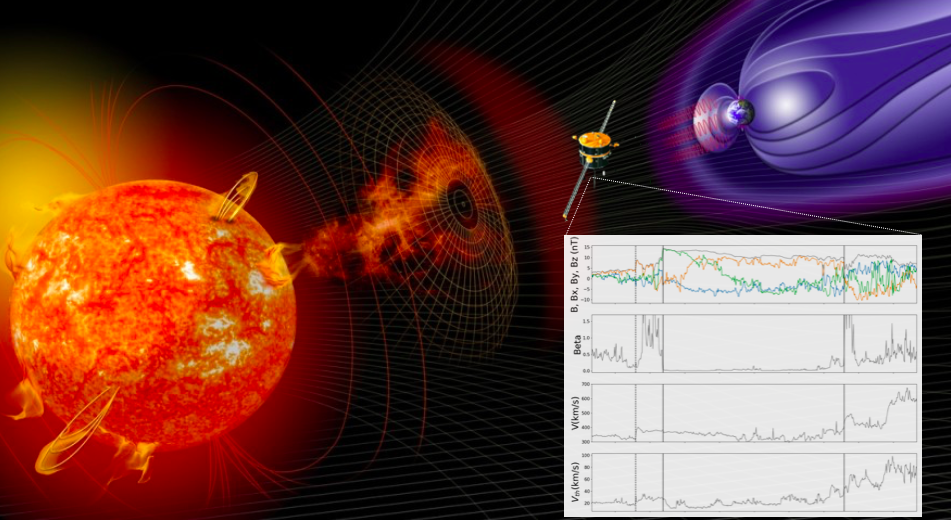RAMP 12: Solar storm detection
Henri Poincaré
INRIA Turing building
The goal of this RAMP is to detect Interplanetary Coronal Mass Ejections (ICMEs) in the data measured by in-situ spacecraft.
ICMEs are the interplanetary counterpart of Coronal Mass Ejections (CMEs), the expulsion of large quantities of plasma and magnetic field that result from magnetic instabilities occurring in the Sun atmosphere (Kilpua et al. (2017) and references therein). They travel at several hundred or thousands of kilometers per second and, if in their trajectory, can reach Earth in 2-4 days.
ICMEs interact with the planetary environment and may result in intense internal activity such as strong particle acceleration, so-called geomagnetic storms and geomagnetic induced currents. These effects have serious consequences regarding space and ground technologies and understanding them is part of the so-called space weather discipline.
ICMEs signatures as measured by in-situ spacecraft thus come as patterns in time series of the magnetic field, the particle density, bulk velocity, temperature etc. Although well visible by expert eyes, these patterns have quite variable characteristics which make naive automatization of their detection difficult. To overcome this problem, Lepping et al. (2005) proposed an automatic detection method based on manually set thresholds on a set of physical parameters. However, the method allowed to detect only 60 % of the ICMEs with a high percentage of false positives (60%). Moreover, because of the subjectivity induced by the manually set threshold, the method had difficulties to create a reproducible and constant ICME catalog.
This challenge proposes to design a machine learning algorithm to detect ICMEs from the most complete ICME catalog containing 657 events. We propose to give to the users a subset of this large dataset in order to test and calibrate their algorithm. We provide in-situ data measurement by the WIND spacecraft between 1997 and 2016 that we sampled to a 10 minutes resolution and for which we computed three additional features that proved to be useful in the visual identification of ICMEs. Using an appropriate metric, we will compare the true solution to the estimation. The goal is to provide an ICME catalog containing less than 10% of false positives while recording as much existing event as possible.
Formally, each instance consists of a measurement of various physical parameters in the interplanetary medium. The training set contains data measurement from 1997 to 2010 and the beginning and ending dates of the 438 ICMEs that were measured in this period.
You will need to output the probability of being in an ICME at each time step. We will compute various metrics on this prediction. We will constrcut predicted ICMEs using this probability vector and score you on the ICMEs of the 2010-2016 period using the recall obtained for a precision of 90%. We will consider an ICME from our test catalog to be detected if it is overlapped by more than 50% by a predicted event.
The following image illustrates the challenge.

Venue: INRIA Turing building
Alexandra Trujillo
Alexandre Boucaud
Ayoub Abraich
Balázs Kégl
Bucciantini Luca
Djinny Volet
Domitille Coulomb
Gautier Nguyen
Giancarlo Fissore
Guillaume Lemaitre
Hugo Breuillard
Joris Van den Bossche
Mandar Chandorkar
Melissa Kouassi
nicolas aunai
Patrick Lee
Richard NIAMKE
roch smets
Sebastien Treguer
Thibault Noël
Vianney Choimet